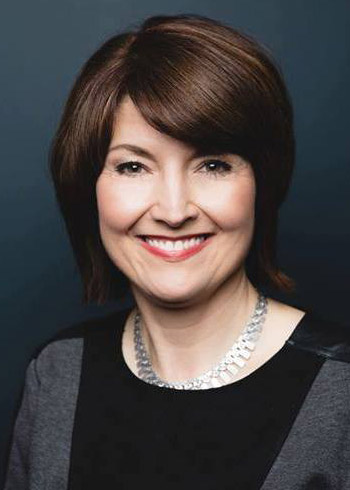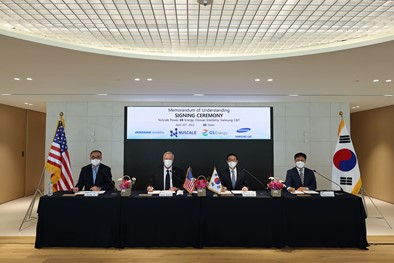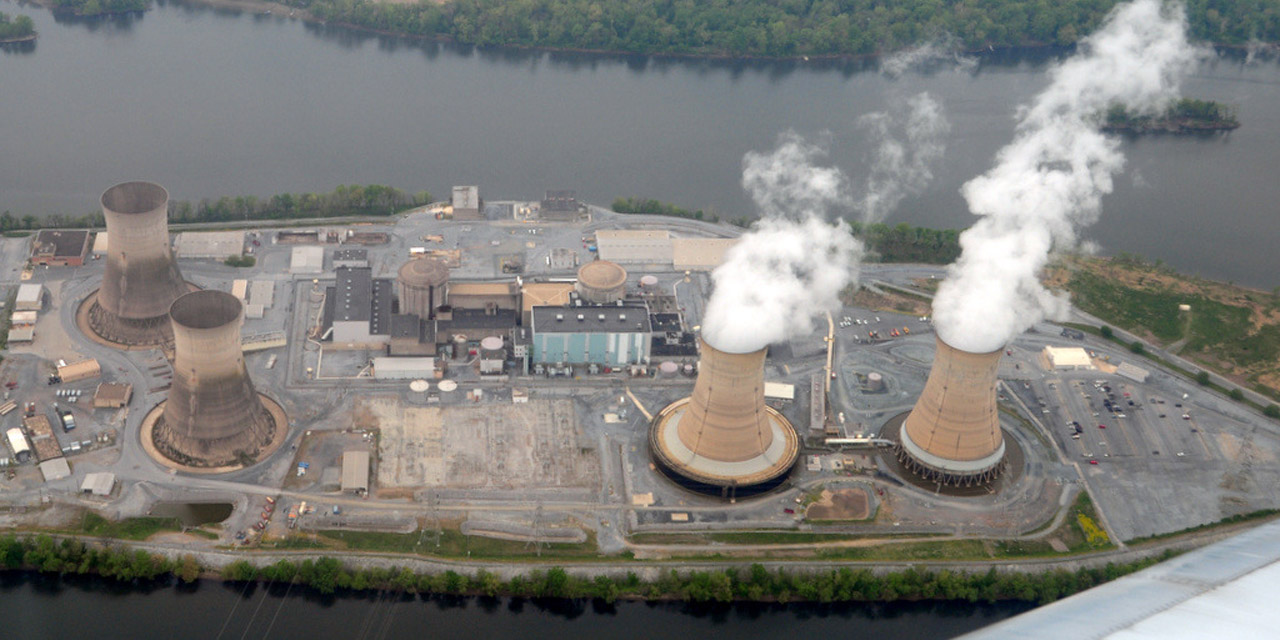An aerial view of the Facility for Rare Isotope Beams on the Michigan State University campus in East Lansing, Mich. (Photo: FRIB)
Michigan State University’s Facility for Rare Isotope Beams (FRIB) officially opened yesterday with a ribbon-cutting ceremony attended by Energy Secretary Jennifer Granholm, elected officials, and guests who had supported the project during its planning and construction, including ANS Executive Director/Chief Executive Officer Craig Piercy. They were there to celebrate the completion—on time and within budget—of the world’s most powerful heavy-ion accelerator and the first accelerator-based Department of Energy Office of Science user facility located on a university campus.
Diablo Canyon nuclear power plant
California Gov. Gavin Newsom told the Los Angeles Times editorial board last week that his administration would look into using the federal government’s Civil Nuclear Credit Program to keep Pacific Gas and Electric Company’s Diablo Canyon nuclear plant in operation beyond its scheduled 2025 closure date.
“The requirement is by May 19 to submit an application, or you miss the opportunity to draw down any federal funds if you want to extend the life of that plant,” Newsom told the board, according to an April 29 LA Times piece. “We would be remiss not to put that on the table as an option.”
Kiyoun Na, chief executive officer of Doosan Enerbility’s nuclear business group; John Hopkins, president and CEO of NuScale Power; Yongsoo Huh, president and CEO of GS Energy; and Byung Soo Lee, executive vice president of Samsung C&T, signed an MOU to collaborate on NuScale SMR deployment in Asia.
Small modular reactor developer NuScale Power has signed a memorandum of understanding with three South Korean companies—Doosan Enerbility Company, GS Energy Corporation, and Samsung C&T Corporation—to explore the deployment of NuScale’s VOYGR power plants in Asia.
Sparked by an article on the TMI accident that appeared in the March 2019 issue of Nuclear News, ANS past president William E. Burchill (2008–2009) offered his own views on the subject. Part 1 of the article appeared in the May 2019 issue of NN and Part 2 was published in June 2019.
The accident at Unit 2 of the Three Mile Island nuclear power plant on March 28, 1979, was an extremely complex event. It was produced by numerous preexisting plant conditions, many systemic issues in the industry and the Nuclear Regulatory Commission, unanticipated operator actions, previously unrecognized thermal-hydraulic phenomena in the reactor coolant system (RCS), and the unprecedented challenge of managing a severely degraded core.
Ukraine’s president, Volodymyr Zelensky, thanks IAEA director general Rafael Mariano Grossi for the agency’s support, including its April 26 mission to Chernobyl. (Photo: IAEA)
The director general of the International Atomic Energy Agency, Rafael Mariano Grossi, led a mission to Ukraine’s Chernobyl nuclear plant this week to address ongoing radiological safety concerns at the shuttered site following five weeks (February 24–March 31) of Russian military occupation.
Mark Brzezinski, U.S. ambassador to Poland, and John Howanitz, president of Bechtel’s nuclear, security, and environmental global business unit, address representatives of 12 Polish companies that signed memorandums of understanding with Bechtel for the potential development of Poland’s civil nuclear program. (Photo: Bechtel)
Bechtel has signed memorandums of understanding with a dozen Polish companies for the potential development of two nuclear power plants as Poland seeks to lessen its dependence on domestic coal and Russian imports for its energy supply.
The MOUs were signed on April 25 during a ceremony at the U.S. ambassador’s residence in Warsaw. Offering services ranging from earthwork and infrastructure construction to concrete, tunneling, electrical installations, and heavy cranes, the 12 Polish firms are BAKS, Budimex, Doraco, Energoprojekt-Katowice, Hitachi Energy Poland, ILF, KB Pomorze, Mostostal Warzsawa, Polimex Mostostal, Protea Group, Vistal Gdynia, and Zarmen.
[CLICK to see entire image] Overview of the SAS-VW program at DIII-D. A research concept map illustrates how intense plasma exhaust power entering the divertor leads to the emergence of impurities that can migrate into the plasma core. After identifying the research requirements for the SAS-VW, a process of engineering design, prototyping, and implementation is performed. (Image: General Atomics)
Researchers at the DIII-D National Fusion Facility (DIII-D) are preparing to test a new method that could enable future fusion power plants to withstand the heat and particle flow created by the fusion reaction, General Atomics reported this week.
Savannah River National Laboratory recently oversaw a demonstration of a new radiological inspection technology called iGART, a ground-based robot that conducts radiological and nuclear inspections. The DOE’s Office of Environmental Management used the demonstration at the Savannah River Site to determine if there is an application value for iGART at SRS or other EM sites. (Photos: DOE)
The Department of Energy’s Office of Environmental Management is looking to continue developing technology to aid in site cleanup activities if its fiscal year 2023 budget request is approved. The $7.64 billion budget request includes about $25 million for EM’s Technology Development Office.
A screen shot from the ANS webinar, “A Reactor Physicist’s Explanation of Chernobyl,” featuring Christopher Perfetti (inset). (Source: ANS)
On the 36th anniversary of the Chernobyl nuclear accident, the American Nuclear Society held the webinar, “A Reactor Physicist’s Explanation of Chernobyl,” led by Christopher Perfetti, an assistant professor in the Nuclear Engineering Department at the University of New Mexico. (Here we use the more common Russian spelling of Chernobyl, rather than the Ukrainian spelling, Chornobyl.)
The Battan nuclear power plant in Morong, Philippines. (Source: Jiru27/Wikimedia)
“If the electorate through their elected leaders demand stable or lower electricity costs, and new coal is off the table, only nuclear power offers hope,” writes nuclear engineer Joseph Somsel in reference to the Philippines presidential election, scheduled for May 9. Somsel, who expressed his views on the Nuclear Engineering International website this month, notes that the leading ticket in the election consists of presidential candidate Ferdinand Marcos Jr., son of the former dictator, and vice presidential candidate Sara Duterte, daughter of the current president. The ticket has been running ads supporting nuclear power while condemning high electricity prices.
Earth Day webinar participants were (clockwise from top left) Craig Piercy, Lindsey Walter, Mikal Bøe, and Shannon Bragg-Sitton. (Image: ANS)
The American Nuclear Society hosted the webinar “Earth Day: Reflections on the Future of Clean Energy” on April 22. Expert panelists discussed the best options for achieving emissions-free objectives, including goals in energy production, industrial activities, and transportation.
















